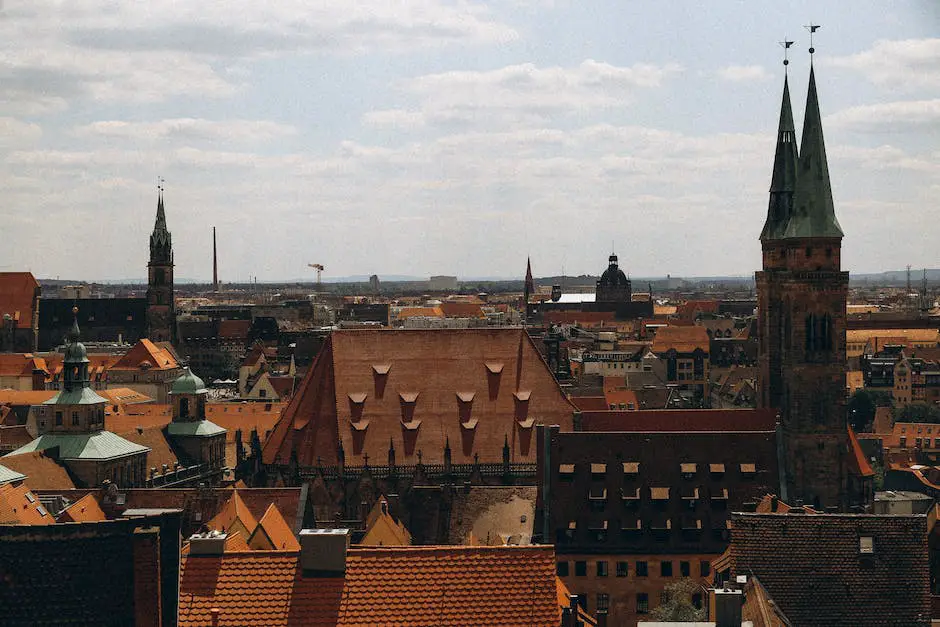
Nestled in the heart of Bavaria, Nuremberg is a city where history leaps from the cobblestones and whispers through the alleyways. It’s a place where the past and present merge, creating a tapestry of architectural marvels that tell tales of bygone eras. As I stroll through the lush greenery of Nuremberg’s parks, I can’t help but marvel at the seamless blend of nature and design. The city’s parks are not just havens of tranquility but also showcases of architectural evolution, reflecting the city’s storied past.
The Medieval Majesty
The story of Nuremberg’s architecture begins in the Middle Ages. The city’s iconic Kaiserburg Castle stands as a testament to this era, its robust walls and towers overlooking the city like guardians of history. Medieval Nuremberg was a bustling hub, and its architecture was a reflection of its prosperity. Timber-framed houses lined the streets, their gabled roofs and intricate facades speaking volumes of the craftsmanship of the time.
Renaissance Revival
As time marched on, Nuremberg embraced the Renaissance with open arms. The city became adorned with grand buildings, such as the Schöner Brunnen, a beautiful fountain that is a masterpiece of stone carving. The Renaissance also brought the expansion of Nuremberg’s parks, with elegant gardens providing a canvas for creative expression. These green spaces became outdoor galleries, displaying the symmetry and order that the Renaissance revered.
Baroque and Rococo Flourishes
The Baroque period added a new layer of opulence to Nuremberg’s cityscape. Churches and palaces were embellished with ornate stucco work, their interiors a dance of light and shadow. The Rococo style soon followed, introducing a lighter, more playful aesthetic. Nuremberg’s parks echoed these changes, with curvaceous pathways and ornamental statues dotting the landscape, inviting visitors to linger and admire.
Industrial Age Innovations
The 19th century heralded the Industrial Revolution, and Nuremberg was at the forefront. The city’s architecture took a pragmatic turn, with factories and workers’ housing rising to meet the demands of the time. Yet, amidst the smokestacks, the city’s parks remained untouched oases. They served as lungs for the city, spaces where the weary could find respite from the industrial grind.
War and Reconstruction
The tumult of the 20th century brought devastation to Nuremberg during World War Ii. Much of the city lay in ruins, its architectural heritage severely damaged. But the city rose from the ashes, and reconstruction efforts aimed to restore its historic character. Modernist principles guided the rebuilding, with a focus on functionality and simplicity. The parks, too, were rejuvenated, their designs reflecting a contemporary ethos while honoring their historical roots.
Contemporary Nuremberg
Today, Nuremberg is a fusion of the old and new. Sleek glass and steel structures coexist with medieval relics. The city’s parks have evolved into dynamic spaces that cater to the modern urbanite. They are not just landscapes but also social hubs, where architecture and nature intertwine to create environments that uplift and inspire.
Nuremberg Parks: A Case Study
Take, for example, the Wöhrder Wiese, a park that exemplifies Nuremberg’s architectural journey. Once a medieval execution site, it has transformed into a vibrant urban park. Its design incorporates sustainable features and serves as a communal living room for the city’s residents. The park’s architecture is a dialogue between the past and present, offering a peaceful retreat while celebrating the city’s resilience.
FAQs
How has Nuremberg’s architecture changed over the years?
Nuremberg’s architecture has evolved from medieval fortifications to Renaissance grandeur, through Baroque and Rococo embellishments, to pragmatic industrial structures, and finally to modernist and contemporary designs. Each era has left its mark, creating a cityscape rich in diversity.
What role do parks play in Nuremberg’s urban design?
Parks in Nuremberg serve as green sanctuaries amidst the urban environment. They are places for recreation, social interaction, and cultural events. The parks’ designs often reflect the architectural trends of their times while providing a natural counterbalance to the built environment.
Can you see the influence of different architectural periods in Nuremberg’s parks?
Absolutely! Nuremberg’s parks are living chronicles of the city’s architectural evolution. From the ordered Renaissance gardens to the contemporary layouts of places like Wöhrder Wiese, the parks mirror the stylistic shifts of the buildings that surround them.
Conclusion
Nuremberg’s architecture is a journey through time, with each era contributing to the city’s unique identity. The parks, in particular, are microcosms of this evolution, blending natural beauty with human creativity. They stand as symbols of Nuremberg’s resilience and its ability to adapt and grow. Whether you’re a history buff, a nature lover, or simply someone who appreciates the art of design, Nuremberg’s parks and architecture offer a captivating experience that’s hard to forget.
In the quest for the featured snippet for “Nuremberg Parks’s Architecture,” let’s remember that Nuremberg’s parks are not just green spaces but historical narratives told through landscape design. They reflect the city’s past, from medieval times to the present day, and showcase the evolution of architectural styles in a harmonious blend with nature. It’s this unique combination that makes Nuremberg’s parks an integral part of its architectural heritage.